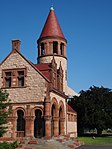Future of Life Institute
2014 establishments in MassachusettsArtificial intelligence associationsExistential risk from artificial general intelligenceExistential risk organizationsFutures studies organizations ... and 3 more
Organizations associated with effective altruismResearch institutes established in 2014Transhumanist organizations
The Future of Life Institute (FLI) is a nonprofit organization that works to reduce global catastrophic and existential risks facing humanity, particularly existential risk from advanced artificial intelligence (AI). The Institute's work is made up of three main strands: grantmaking for risk reduction, educational outreach, and advocacy within the United Nations, US government and European Union institutions. Its founders include MIT cosmologist Max Tegmark and Skype co-founder Jaan Tallinn, and its board of advisors includes entrepreneur Elon Musk.
Excerpt from the Wikipedia article Future of Life Institute (License: CC BY-SA 3.0, Authors).Future of Life Institute
Irving Street, Cambridge
Geographical coordinates (GPS) Address Nearby Places Show on map
Geographical coordinates (GPS)
| Latitude | Longitude |
|---|---|
| N 42.3736158 ° | E -71.1097335 ° |
Address
Cambridge Rindge & Latin School
Irving Street
02143 Cambridge
Massachusetts, United States
Open on Google Maps









